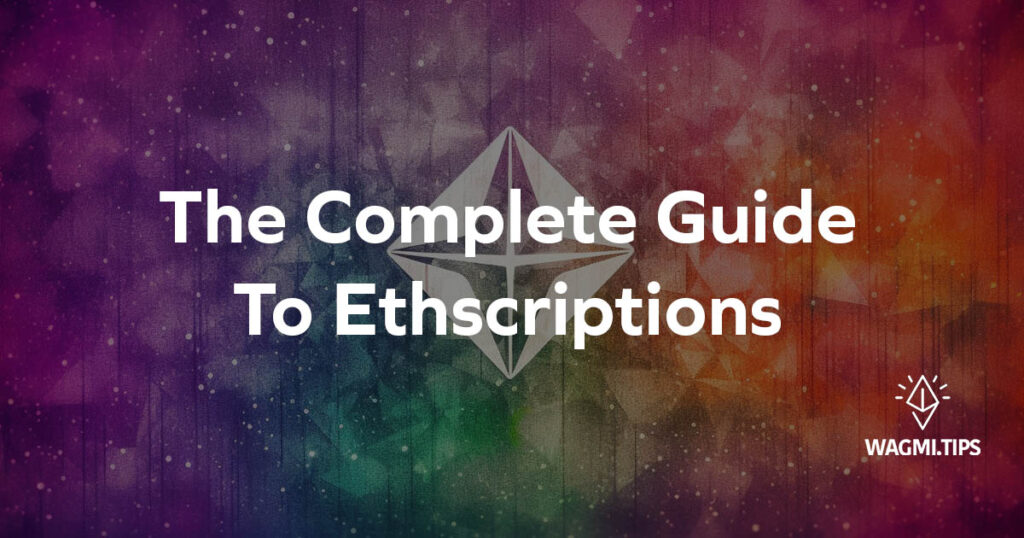The Complete Guide To Ethscriptions: What You Should Know
Ethereum community, ever known for its innovation, experimentation, and tireless quest for improved functionality, has gifted the world with another cutting-edge protocol, Ethscriptions. Evoking parallels with Bitcoin’s Ordinals, this new protocol presents a fresh and revolutionary approach to minting nonfungible tokens (NFTs) on Ethereum.

Table of Contents
What Are Ethscriptions?
Ethscriptions is a new protocol, designed to create NFTs and other digital assets on the Ethereum blockchain. Developed by Tom Lehman, co-founder of Genius.com, Ethscriptions uses Ethereum’s “calldata” to enable a cost-effective, decentralized minting process that is cheaper and more streamlined than conventional smart contract-based methods.
Drawing inspiration from Bitcoin’s Ordinals, where assets are referred to as “inscriptions,” Ethscriptions allows users to “ethscribe” images directly onto the Ethereum main chain, as long as they are less than 96 kilobytes in size. The project has shown a promising start with nearly 30,000 Ethscriptions created within the first 18 hours of its launch.
While currently limited to image-only inscriptions, Ethscriptions aims to accommodate different file types in the future.
How Are Ethscriptions Different From Bitcoin Ordinals?
Like Bitcoin Ordinals, Ethscriptions pushes the boundaries of blockchain technology beyond financial transactions. Both protocols offer a medium to inscribe non-financial data, but they use different methods. While Ordinals use Bitcoin’s transaction data, Ethscriptions leverages Ethereum’s calldata.
The Ethereum community’s enthusiasm for innovation and experimentation played a vital role in the overwhelming acceptance of Ethscriptions, unlike the mixed response Bitcoin Ordinals received from Bitcoin maximalists.
How Do Ethscriptions Work?
An Ethscription is created when a successful Ethereum transaction has valid input data (interpreted as UTF-8) that is a valid data URI. However, this data URI must be unique, meaning it can’t match the content of any Ethscription from a previous block or a transaction earlier in the same block.
An Ethscription transfer is valid when the input data of an Ethereum transaction is the transaction hash of a valid Ethscription, and the transaction sender is the current Ethscription’s owner.
The recipient of the creation transaction becomes the initial owner of the Ethscription, and the sender of the transaction is deemed as the creator of the Ethscription.
How To Create An Ethscription?
Creating an Ethscription is a straightforward process. Follow the steps below to create yours:
Convert your chosen image, which should not exceed approximately 90KB in size, into a Base64-encoded data URI. You can use online services like base64-image.de to facilitate this process. Although Ethscriptions support all data URIs, images work optimally.
Convert the data URI obtained from the previous step to hex using an online tool such as hexhero.
Send a “0 ETH” transaction to the proposed owner of the Ethscription. Input the hex data from step 2 into the “Hex data” field.
Wait for a few moments. If no one has Ethscribed the same data, your Ethscription should appear on the official Ethscriptions site. Remember, the protocol ignores any duplicate content.
How To Transfer Ethscriptions?
Transferring Ethscriptions involves a few simple steps:
Identify the transaction hash of the Ethscription you want to transfer. This hash acts as the unique ID for the Ethscription. Websites like Etherscan or the official Ethscriptions site can assist you in finding this.
Send a zero-ETH transaction to the new proposed owner. Include the Ethscription ID (from step 1) in the “Hex data” field.
Wait for a few moments. If you were the owner of the Ethscription when you sent the transfer transaction, the Ethscription’s ownership should update on the official site. Unauthorised transfers are ignored.
How To Track Ethscriptions?
Ethscriptions can be easily tracked using the official website. However, if you prefer not to rely on external services, you can independently monitor the transactions as all the necessary data is publicly available and uncensorable.
To track Ethscriptions yourself, you will need an indexer. The indexer that powers the official website will soon be open-source, but you can also create your own indexer following the relevant rules. You can obtain historical data from BigQuery and use Alchemy APIs for real-time data.
Potential Implications and Challenges
One of the key implications of Ethscriptions and similar protocols is the potential increase in transaction costs. This was seen with Bitcoin’s Ordinals, and the same is anticipated with Ethereum’s Ethscriptions, considering Ethereum’s already high transaction fees.
Summary
Though Ethscriptions is still in its early stages, the possibilities it presents are immense. From its initial limitation to inscribe images, Ethscriptions aims to incorporate other file types in the future, opening up a wide range of potential applications. Its swift adoption and the Ethereum community’s support for such innovative initiatives underscore the growing appreciation for blockchain technology.
However, its longevity hinges on sustained community engagement and adoption. While some argue similar technologies have existed for years, the innovative spirit of Ethereum and the blockchain universe continues to seek new territories to explore.
Visit The Official Ethscription Website: https://ethscriptions.com
